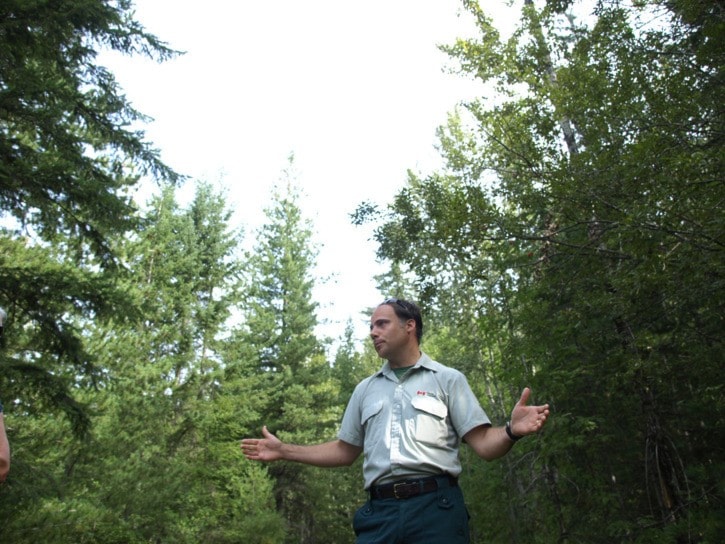What are those trees you see and what’s happening to them? Gregg Walker lets us know
Gregg Walker is of average height and build with slightly greying sideburns. He’s spent 20 years working as a forest ecologist with Parks Canada, including the last 10 as a fire and vegetation specialist. He fell in love with forests while working a summer job coring trees in Saskatchewan.
“It was incredibly tedious work, coring the trees one-by-one, but I fell in love with it,” he said during a guided forest walk he gave around the Five Kilometre trail in Mount Revelstoke National Park Saturday morning.
He definitely knows his forests. We only made it a few hundred metres around the loop before an hour had elapsed during which he dispensed the ten of us that joined him with just some of his wisdom.
The talk, Secrets of the Columbia Forest – Forest Ecologist’s Perspective, was presented by the BC Interior Forestry Museum. We met at the Nels Nelsen parking lot and strolled up to the base the historic Nels Nelsen ski jump. Within a few metres of where we we stood were several species of trees - Douglas fir, western white pine, aspen, black cottonwood, birch and more.
“The really interesting thing about this forest is that it has the most diverse mix of conifers in western Canada,” Walker told us. There are nine different kinds of conifers and five or six species of deciduous trees in the forests around Revelstoke, he said.
That variety is a boon for the forest and helps it survive and thrive, especially compared to its less varied counterparts to the east and west that were ravaged by the mountain pine beetle, Walker said.
“Forest ecologists discovered if you have a diverse forest it is more resilient that if you didn’t,” he said. “Age and tree health and diversity of tree specie all affect how diseases and insects impact the forest overall.”
It’s a rough life for trees – diseases and bugs are constantly threatening them, worms chew on the leaves, fungus grows weakens the roots and moth larvae attacks from above.
Fortunately, trees are pretty resilient – they have their own immune systems designed to fight off diseases and it can take up to 80 years for them to succumb.
Walker pointed out a western white pine suffering from pine needle rust. Some of the needles were an orange-red colour, caused by a disease that was imported from Asia or Europe. The disease starts on the needles and works its way into the park, eventually killing off the tree.
One of the big concerns right now is the western hemlock looper moth. In 2002 an outbreak took place in the area and threatened the forests. “It was prolific and everyone thought the whole forest would die off but it didn’t,” said Walker.
Research shows outbreaks take place about every ten years so Parks Canada is preparing for another outbreak next year. Fortunately, the looper has its own enemy – wasps that lay their eggs right inside the larvae. “This is really gross stuff,” Walker said.
We walked past a giant spruce tree that towered above its neighbours. Walker estimated it was about 40 metres tall and 100- to 250-years-old.
“These sites in the Columbia Mountains are super-productive,” he said. The heavy precipitation means a tree that gets a good start and grows in the right place can boom.
